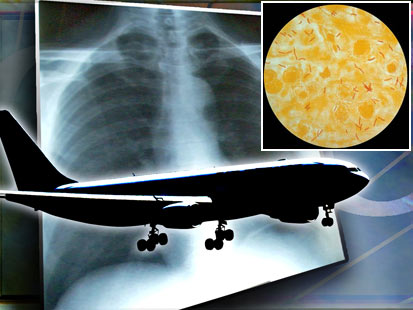Travel Sick: 5 Travel-Related Infections
By land, by sea or by air, here are the bugs that could wreck your vacation.
April 3, 2009— -- As the warm weather of spring approaches, many look forward to packing their bags and zipping off to an exotic locale.
However, travel is not always a disease-free proposition. Indeed, numerous media reports have cited potential risks from infectious diseases that you could catch while traveling -- from the common cold to tuberculosis.
"There are 229 countries in the world, and there are different diseases in every country," said Dr. David Freedman, professor of geographic medicine at the University of Alabama at Birmingham and director of UAB's Traveler's Health Clinic.
Of course, not all of these threats are terribly serious, or even likely. But others can be the worst thing to happen to your beach vacation since the unexpected, week-long thunderstorm.
So which infections should you be worried about? Which fears should you dismiss? And what can you do to keep yourself healthy during your time away from home?
The following pages feature some infections that have gotten media attention in the past -- as well as how to deal with these often-microscopic travel foes.
By Air: Scabies
Last Thursday, reports emerged that several Transportation Security Administration (TSA) personnel at Boston's Logan International Airport were found to have been infected with scabies -- an itchy condition brought about by an infestation of the skin with mites.
According to the U.S. Centers for Disease Control and Prevention (CDC), these microscopic critters can be passed through skin-to-skin contact. Once transmitted, the mites burrow into the upper layers of the skin and lay their eggs there.
In addition to bringing on an intense itch, scabies is a condition known for its pimple-like skin rash.

"Since the 14th of March we had eight suspected cases of scabies," said TSA spokeswoman Ann Davis.
On Wednesday, Davis said that testing revealed that only two of these suspected cases among security personnel were confirmed to be scabies. One was in a worker at a security screening checkpoint, who was involved in body searches on some passengers. The other, who was found to have had a milder case, worked as a behavior detection officer and had no physical contact with passengers.
Davis added that since TSA officers wear gloves while on duty, it is unlikely that the infection could have been passed along. Still, she said, the TSA took a number of precautionary measures in response to the cases, including an order for TSA employees to wash all of their clothes and uniforms and a thorough cleaning of the checkpoint.
Dr. William Schaffner, chairman of preventive medicine at Vanderbilt University Medical Center and travel disease expert, agreed that even passengers who we screened by this worker likely have little to worry about.
"The threat, I think, is pretty low because the contact is pretty transient," he said. "It takes a little while for the parasites to get from one person to another.
"The risk to travelers -- even if the traveler got patted down -- must be very low."
How to Protect Yourself
Even though the chance of getting scabies at an airport may be relatively low, Schaffner said that there are still precautions that people can take to avoid the bugs in their day-to-day lives.
Among these precautions, he said, is to make sure that you do not share any clothes with someone who is infected with scabies. You should also try to avoid being in close proximity to them, such as when you are sleeping beside them in a bed.
By Sea: Norovirus
Part of the draw of a luxurious cruise ship is the ability to leave the land behind. Unfortunately, many infectious germs are not so easily abandoned.
One of these germs is norovirus -- a notorious stowaway on cruise ships that is responsible for several high-profile outbreaks each year.

The CDC identifies noroviruses as a common culprit of "stomach flu" -- technically referred to as gastroenteritis. Those infected with norovirus generally feel extremely sick and may vomit several times a day. In severe cases, vomiting and diarrhea can leave an infected person dehydrated and in need of medical attention.
"There continue to be three to four significant outbreaks per year," Freedman said. "The CDC considers a significant outbreak to be when more than 2 percent of people on a cruise come down with norovirus. One cruise last year had an 8 percent attack rate, so that's hundreds of people."
Fortunately, Freedman said, norovirus has been largely controlled through guidelines on ship sanitation and strict attention to hygiene regulations.
Schaffner agreed.
"The cruise industry has becomes absolutely obsessive with personal hygiene," he said, "specifically hand hygiene."
He noted that two of his colleagues who recently went on a cruise reported that they were not allowed into the dining area of the ship without being given a sanitary hand wipe.
How to Protect Yourself
Make sure to adhere to all recommended hygiene regulations on your ship, and you should be alright.
Additionally, Schaffner said that travelers who are planning to take a cruise can further protect themselves by ensuring that they have their own supply of sanitary wipes handy.
"Any of these alcohol-based gels or sanitary wipes, if you take some of them with you they will be available at all times."
By Air: Tuberculosis
When news broke two years ago that Atlanta attorney Andrew Speaker boarded an international flight even though he was infected with tuberculosis, outrage followed.
Since then, this scenario has repeated itself several times -- most recently on March 16 when the CDC announced that a passenger on a flight from Germany to Detroit had been diagnosed with tuberculosis.
"Tuberculosis has certainly been well documented to be transmitted on airplanes," Freedman said.

Fortunately, the problem is a relatively rare one. Indeed, on any given day, more than 87,000 flights are in the skies in the United States, according to statistics from the National Air Traffic Controllers Association. But last year, United States health officials barred a grand total of just 33 tuberculosis-infected people from flying.
And even if you happen to be sitting near a fellow passenger who has tuberculosis, the risk of transmission remains fairly small.
"I think that frankly -- and fortunately -- the risk is close to zero for transmission," Schaffner said. "These are extremely unusual events, and even when [health officials] have followed up, they almost never find any cases of transmission."
Freedman agreed.
"The actual number of people that get tuberculosis on airplanes is probably infinitesimal compared to the thousands of people who travel on an airplane every year," he said.
How to Protect Yourself
If you are concerned that a nearby passenger has tuberculosis -- or, in fact, any respiratory infection -- you might do best to try to move as far away as possible.
"You generally have a range of about three feet or so [for transmission of viruses]," Freedman said. "Even on airplanes, many people blame the ventilation system and things like that, but really it's who you're sitting next to. We call it the 'two-seat' rule."
"If you are sitting next to someone who is coughing and you are worried about tuberculosis or another infectious disease, you can ask to change your seat," Schaffner suggested.
But barring that, he said, you might want to ask the sick person beside you to use a tissue to cover their coughs.
A tissue? Don't laugh. Schaffner said that in the age of tuberculosis sanatoriums, patients who were institutionalized for their infections were first taught to cover their coughs with a tissue. This, apparently, was enough to prevent those in the sanatorium who were not infected with the bacterium from catching it.
By Land: Cold and Flu From Mass Transit
The next time you find yourself packed into a crowded train or bus during your vacation, you might try not to think too much about the germs you could be breathing in -- particularly for the cold and flu.
"Most of these illnesses are transmitted within a breathing space," Schaffner said -- which means that the flu virus that your traveling neighbor has may soon be yours if you aren't careful.

How to Protect Yourself
So what is the best advice to avoid an infection? As with the seating on an airplane, location is everything.
"Get somewhere and sit somewhere else," Dr. Howard Markel, professor of the history of medicine and of pediatrics and communicable diseases at the University of Michigan Medical School, told ABCNews.com in September. "If someone is coughing, I would avail myself that opportunity. Our mothers were right when they said, 'Don't let anyone cough on you.'"
More often than not, however, trains and buses are so packed that it's difficult to remove yourself from such situations. If you find yourself trapped, it may be best to try and limit your exposure as much as possible.
"Breathe shallowly," Markel recommended. "Try not to let [people] cough on you."
In that way, he explains, transmission of germs can be reduced.
As on cruise ships, the surfaces that you touch can also harbor some nasty bugs. However, Schaffner said, these surfaces are less likely to be a source of viral transmission in these cases. With this in mind, he said, people should still be practicing safe hand hygiene if they are in such situations.
By Land: Bedbugs on Subways and in Hotels
A commonly known nuisance, bedbugs are known for the red, itchy bumps that their bites leave on the skin of unsuspecting travelers.
According to reports from the U.S. Public Health Service, bedbugs are known to carry dozens of infectious diseases, from smallpox to the flu.
Last May, Edward Brownbear, lead education instructor for the Department of Housing, Preservation and Development (HPD) in New York City, told an audience at a seminar that the city's trains and stations may be infested with bedbugs.

Brownbear reportedly said he had seen the bugs on the wooden benches of Manhattan's Union Square station and The Bronx's Fordham Road station -- as well as on the clothing of a passenger on a train.
The HPD later distanced itself from Brownbear's comments, but concerns persisted. And the latest research suggests that the bedbug problem is becoming more common worldwide, as the critters are unknowingly transported by travelers.
Schaffner said that even apparently tidy hotel rooms can be a hotbed for the bugs.
"When you travel, you stay in a lot of strange beds," he said. "I'm pretty sure I had one experience of bedbug bites in my travels, and it was in a very decent hotel. A lot of this has to do with who was there before you."
How to Protect Yourself
The bad news is that as long as you are staying in a bed that is not your own, it is hard for you to control the level of bedbugs in your vicinity as you travel.
Fortunately, research has shown that though bedbug bites can spread disease, such diseases from these bites are rare.
"It's not an event that I would be concerned about," Schaffner said.
'Traveler's Diarrhea' and Other Bad Travel Bugs
OK, we know we said five infections. But what story about travel illness could be complete without a mention of Montezuma's revenge?
Both Schaffner and Freedman agreed that travel diarrhea is perhaps the most common -- and one of the least pleasant -- vacation-related afflictions most travelers will be likely to encounter.
"This is one of those illnesses where if you have it, you're afraid that you're [not] going to live," Schaffner said.

The source can be any one of a number of microscopic bugs, most of which are viral in nature.
Schaffner said that travelers may be particularly at risk if they are traveling to a developing country.
"When traveling there, the admonitions about what you eat and drink become very, very important," he said. "Don't eat it unless it can be peeled or cooked."
Bottled water is a good idea. And cold food is probably a bad one -- even if it is a dish commonly believed to be a healthy one.
"In the words of my mentor, 'You can only sterilize salad with a blowtorch,'" Schaffner said.
As long as you're packing the bottled water, Schaffner recommended throwing in a few condoms as well, as wild vacations often provide ample opportunities for some to contract any one of a host of sexually transmitted diseases.
But perhaps the best thing you can do for yourself is to prepare for your trip by seeing a specialist after you buy your tickets -- but before you board your flight.
"My recommendation is always that people should see not just their primary care physician before they travel, but also a specialist at a traveler's health clinic prior to their trip," Freedman said.
Jenny Chan contributed to this report.